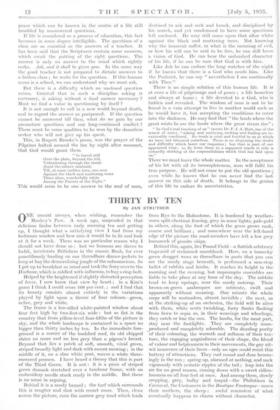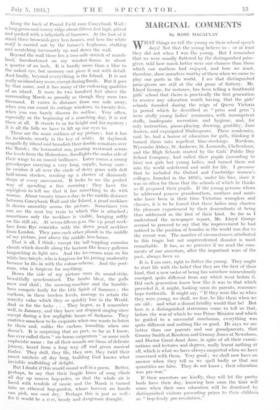THIRTY BY TEN
By JAN STRUTHER
ONE should always, when wishing, remember the Monkey's Paw. A week ago, suspended in that delicious limbo between early morning tea and getting up, I thought what a satisfying view I had from my bedroom window and how nice it would be to lie and look at it for a week. There was no particular reason why I should not have done so : but we humans are slaves to habit, inveterate Britishers in the cosmic Bush, for ever punctiliously hauling on our threadbare dinner-jackets to keep at bay the demoralizing jungle of the subconscious. So I got up to breakfast as usual and took the ferry over to the Harbour, which is riddled with influenza, to buy a ring-bolt.
Helped by the heightened if slightly distorted perception of fever, I now know that view by heart ; in a Rim's game I think I could score 100 per cent. ; and I find that its beauty consists almost entirely in the variations played by light upon a theme of four colours—green, ochre, grey and white.
The frame is a low-silled white-painted window about four feet high by two-feet-six wide : but so flat is the country that from pillow-level four-fifths of the picture is sky, and the whole landscape is contained in a space no bigger than thirty inches by ten. In the immediate fore- ground is a corner of the toolshed roof, its old chipped slates no more and no less grey than a pigeon's breast. Beyond that lies a patch of soft, smooth, vivid green, striped broadly light and dark with recent mowing ; in the middle of it, on a slim white post, waves a white three-. cornered pennon. I have heard a theory that this is part of the Third Green. It is not : it is a piece of striped green damask stretched over a tambour frame, with an embroidery needle stuck ready in the middle. But there is no sense in arguing.
Behind it is a sandy hazard ; the turf which surrounds this is rougher and shot with russet moss. Then, clean across the picture, runs the narrow grey road which leads from Rye to the Holmstone. It is bordered by weather- worn split-chestnut fencing, grey in some lights, pale-gold in others, along the foot of which the grass grows rank, coarse and brilliant ; and somewhere near the left-hand edge of the picture the road-menders have left a low grey hummock of granite chips.
Behind this, again, lies Pound Field—a flattish arbitrary trapezoid of reclaimed marshland. Here, on a tussocky green drugget worn so threadbare in parts that you can see the sandy stage beneath, is performed a non-stop ballet of rabbits and Iarnbs. It reaches its height in the morning and the evening, but impromptu ensembles are liable to take place at any hour of the day. The rabbits tend to keep upstage, near the sandy outcrop. Their brown-on-green arabesques are intricate, swift and apparently without meaning. One minute the whole corps will be motionless, almost invisible ; the next, as at the striking-up of an orchestra, the field will be alive with them, white scuts twinkling, furry flanks flashing from fawn. to sepia as, in their weavings and wheelings, they catch or lose the sun. The lambs, for the most part, stay near the footlights. They are completely mass- produced and completely adorable. The dazzling purity of their colouring, the warmth and softness of their tex- ture, the engaging ungainliness of their shape, the blend of valour and helplessness in their movements, the gay nit- wit innocence of their faces—only an ogre could resist this battery of attractions. They curl round and doze becom.e ingly in the sun ; spring up, alarmed at nothing, and suck vigorously with ecstatic ripples of the tail ; leap into the air for no good reason, coming down with a sweet ridicu- lousness on all four feet at once. And among them, slowly cropping, grey, bulky and torpid—the Philistines in Carnaval, the Customers in the Boutique Fantasque—move their mothers, the sheep ; awful reminders of what eventually happens to charm without character. Along the back of Pound Field runs Coneybank Wall : a long green-and-tavvny ridge about fifteen feet high, pitted and pocked with a labyrinth of burrows. At the foot of it stand three brownish-grey hen-houses, and here the white motif is carried out by the farmer's Leghorns, stalking and scratching incessantly up and down the wall. Beyond the wall there lies a two-mile stretch of marsh- land, foreshortened on my window-frame to about a quarter of an inch. It is hardly more than a blur to the naked eye, but memory can piece it out with detail. And finally, beyond everything, is the Island. It is not really an island any more, except during floods. But it goes by that name, and it has many of the endearing qualities of an island. It rears its two hundred feet above the surrounding Marsh as proudly as though they were two thousand. It varies in distance from one mile away, when you can count its cottage windows, to twenty-five,' when you can barely discern its outline. Very often, especially at the beginning of a scorching day, it is not there at all. It stands to us for height and for mystery : it is all the hills we have to lift up our eyes 'to.
These are the main outlines of my picture ; but it has its incidents, mostly in the key of. white. At daybreak seagulls fly inland and brandish their double scimitars over the Marsh ; the horizontal sun, pouring westward across the levels from the Holmstone, floodlights the under side of their wings to an unreal brilliance. Later comes a young greenkeeper carrying a very long; supple, tawny cane : he swishes it all over the circle of dewy grass with deft half-moon strokes, sending up a shower of diarnondy drops at .every movement. It looks to me the perfect way of spending a fine morning : they have the espieglerie to tell me that it has something to do with worms. About twenty times a day, in the middle distance between Coneybank Wall and the Island, a pearl necklace is drawn smoothly across the picture. Sometimes you can see the neat toy train to which this is attached ; sometimes only the necklace is visible, hanging softly on the still air. At seven-fifteen p.m. the t p pearl neck- lace from Rye coincides with the down pearl' necklace from London. They pass each other plumb in the middle of my picture, just above the middle hen-house.
That is all, I think : except the tall toppling cumulus clouds which dawdle along the horizon like heavy galleons languishing in light airs. And the ice-cream man on his white box-tricyle, who is forgiven for his jarring modernity because he fits in with the colour-scheme. And the post- man, who is forgiven for anything. Down the side of my picture runs its sound-strip, beautifully synchronised. The lambs bleat, the gulls mew and skirl ; the mowing-machine and the bumble- bees compete lazily for the title Spirit of Summer ; the cuckoos, in these treeless levels, manage to retain the scarcity value which they so quickly lose in the Weald. And as for the larks . . . They began, as I remember well, in January, and they have not stopped singing since except during a few negligible hours of darkness. They contrive somehow to be exquisite when one wants to listen to them and; unlike the cuckoo, inaudible when one doesn't. it is surprising that no poet, so far as I know, has ever called them " air-borne carpenters " or some such . euphuistic name : for all their sounds are those of delicate joinery, heard from a long way off and given musical timbre. They drill, they file, they saw, they twirl their sweet ratchets all day long, building God knows what invisible scaffolding of delight. But I doubt if this would sound well in a poem. Better, perhaps, to .say that their fragile bines of song climb all day up unseen hop-poles, so that the whole air is laced with tendrils of music and the Marsh is turned into an ethereal hop-garden, whose harvest no hands can pick, nor oast dry. Perhaps this is just as well : i for it would be a re- re, heady and dangerous draught.















































 Previous page
Previous page